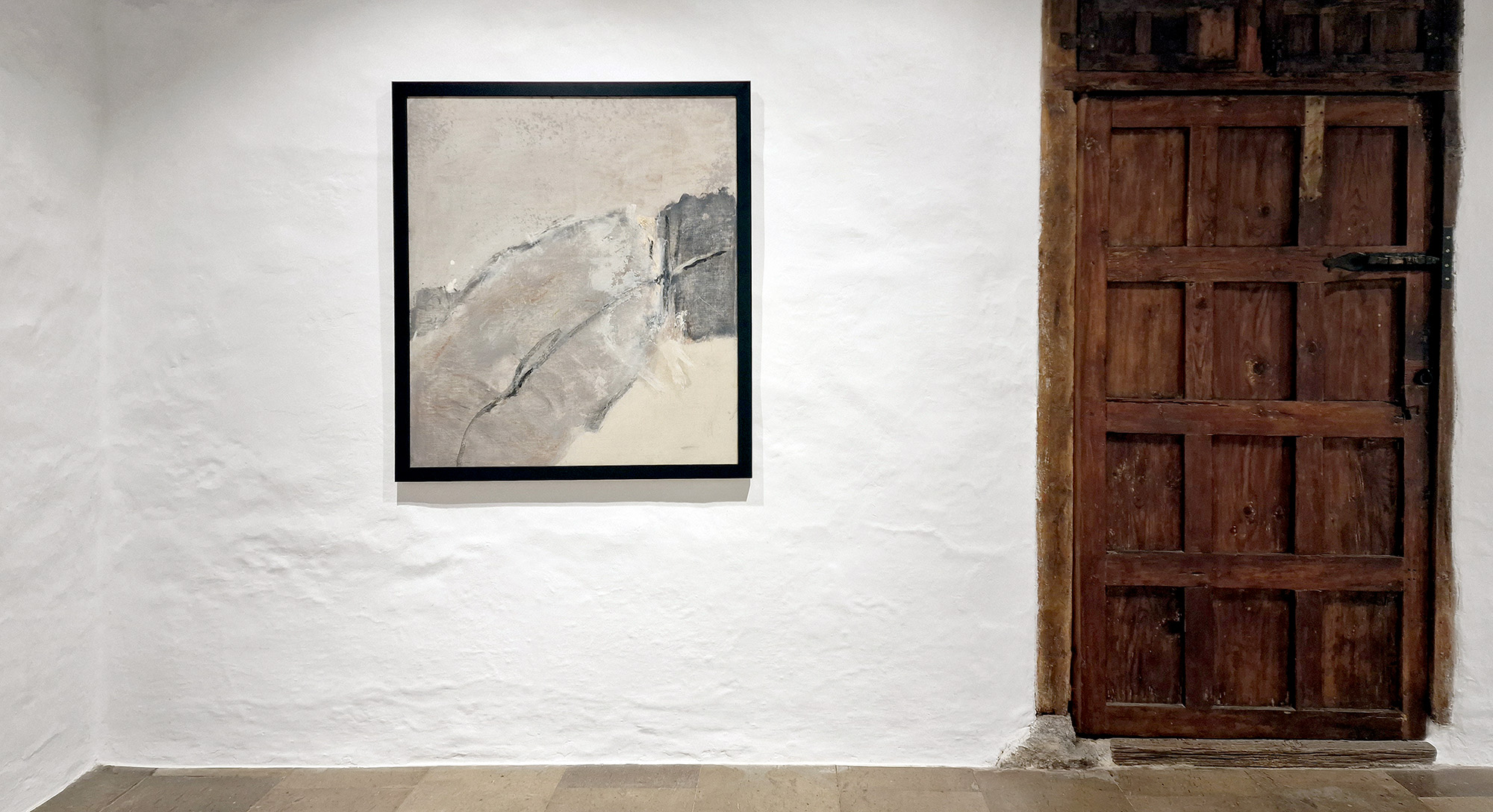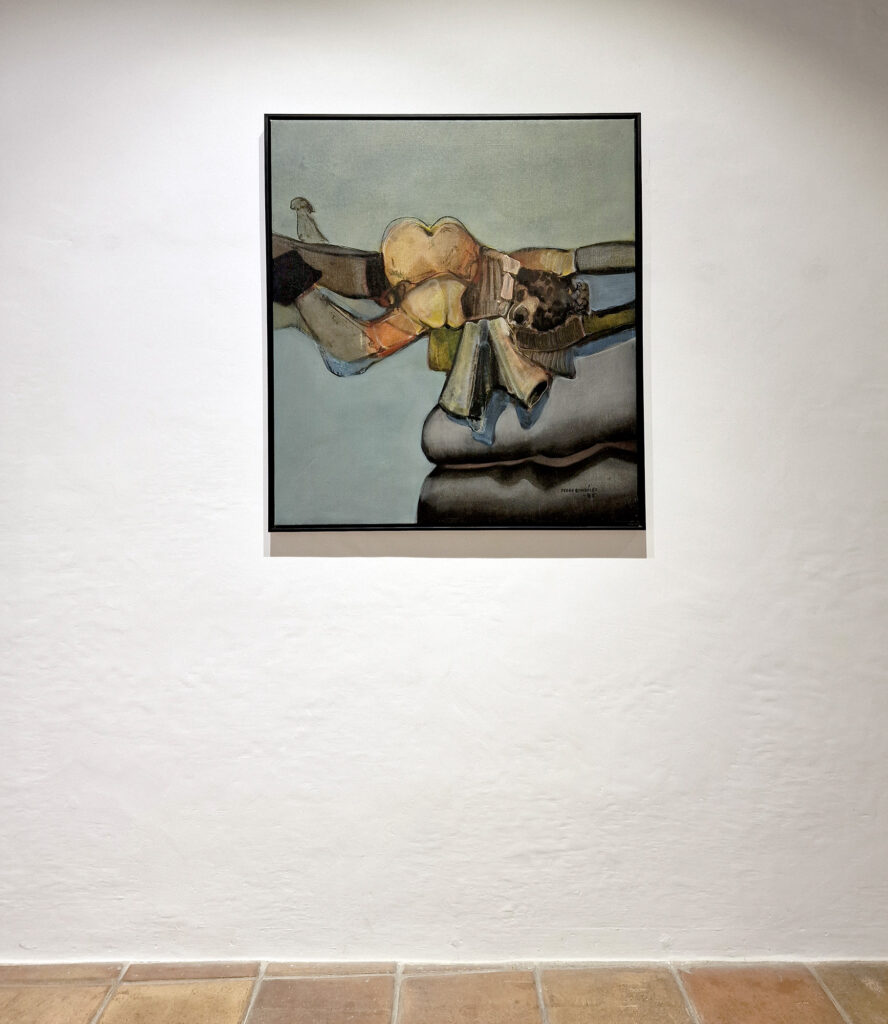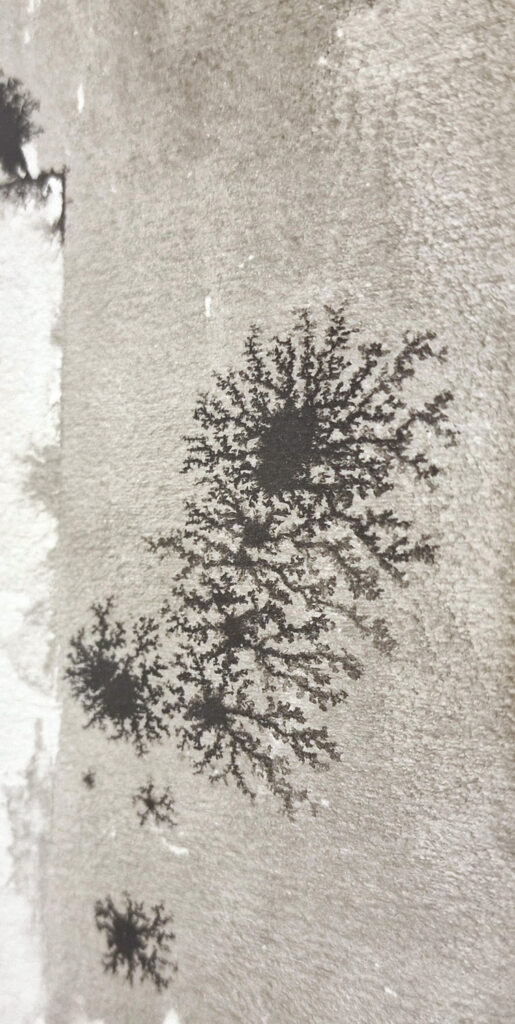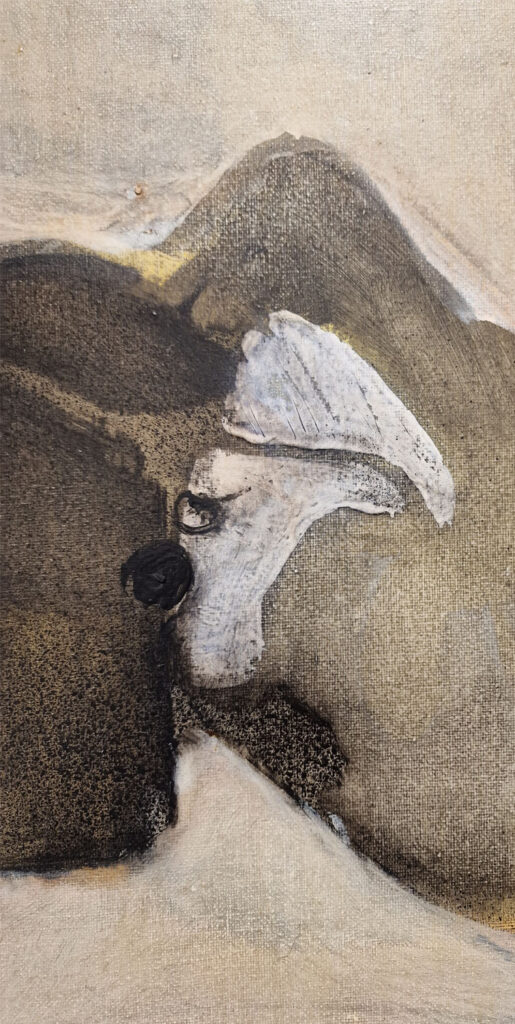Estremecimiento (Trembling) (Early Work 1954-1985)
“Cosmoarte is a cosmic trembling of things”
Pedro González
Posterity undeniably sifts the work of every artist that, having been contemplated and understood in life under the conditions and circumstances of the everyday, following their death, will begin to be appreciated through the lens of increasingly removed criteria, tastes, fashions, or concerns. Over the next few years, friends and lovers of art throughout the Canary Islands and particularly in Tenerife should feel moved to review, reconstruct, rethink, and re-evaluate in all its dimensions the life and work of painter Pedro González (San Cristóbal de la Laguna, 1927 – 2016), who would have been 100 in five years’ time. And not only in the face of a foreseeable celebration of this centennial; we should be motivated, above all, because the work that González created in his tremendous dedication to painting for more than half a century is no longer the responsibility of anyone in particular but of the society that received it, which recognised and acquired it, incorporating it into domestic life, exalting it disproportionately within institutional life: a cultural artefact and heritage of the art collecting world in the Canary Islands that does not deserve to be abandoned to inertia.
No one doubts the importance of Pedro González in the evolution of contemporary painting in the Canary Islands: alongside Millas, Manrique, and De Vera, he is one of the most important figures in the second half of the 20th Century. However, the posterity of his work does not bode well, afflicted with insular weaknesses that a systematic approach should be able to reverse.
Six years have passed since the painter’s death, and his active presence in the artistic and cultural life of the Canary Islands for more than half a century, whose lights and shadows still reach us today, together with his “incombustible productivity” (Ángel Sánchez dixit) glimpsed through a staggering body of work between the mid-20th Century and the year 2011, remain significant obstacles to be able to gauge his contribution and transcendence in the development of Spanish art in the second half of the 20th century. Overcoming these obstacles will undoubtedly be a matter of time, but as far as knowledge of his work is concerned, the relative immediacy of his centenary offers an ideal opportunity to revisit his work right to its very core, which should, after all, be the basis of his well-deserved ensuing posterity. The unexpected coincidence in 2022 of two exhibitions dedicated to the work of Pedro González, promoted by private cultural spaces open to the public in his hometown – one presented by Arte LM Colección exploring Icerse and the preambles of Cosmoarte and the other one presented now by Galería Artizar – would suggest that such an endeavour is tacitly underway.
Contributing to the recovery of Pedro Gonzalez’s catalogue and knowledge of his work is one of the aims of this exhibition, composed of works created in pastels, monotypes, paintings, gouaches, and lithographs made between 1954 and 1985, exploring his early work (Icerse ) and the extensive subsequent cycle with which he firmed up his own diction (Cosmoarte), since both are justified by two deterministic and unique aspects of his creative intention: the search for a style, in other words for a pictorial identity; and the elusive, disturbing, and drawn-out process of giving human form, female form to be precise, to the smear on the canvas. Just between the two origins, the official start of his oeuvre and the origin of the pictorial world that came from it, we find Estremecimiento (Trembling) at Galería Artízar, an encounter with the early work of painter Pedro González.

Although Icerse is generally understood to mark the beginning of Pedro González’s artistic project, what he called “his own painting,” the rediscovery of his ‘prehistory’ illustrates his previous skills, concerns, and lineage. The five costumbrista pastel studies dating from 1954 that introduce this exhibition, created a year before he set off for Venezuela, reveal the descriptive force of his stroke and the sublimation of the instant, captured amidst enveloping masses of colour. One of them, barely insinuated and entitled Corrida, pushes to the very edge of significance the limit that, having returned to the Canary Isles, the material and intellectual instruments of his Venezuelan experience will help him to transcend. Shown here for the first time, the drawings exhibited were held in high esteem by the artist himself, who seemed to view them as so much more than a mere training exercise when he documented their existence in 1985, in the catalogue compiled for the first retrospective exhibition of his work promoted by the Regional Government to mark Canary Islands Day.
Following his return from Venezuela, González embarked on a series of essays on paper that he called “monotypes,” heavily influenced by his direct experiences of international contemporary art in Venezuela and especially by his discovery of Japanese engraving and art. In these “monotypes”, he makes use of engravings to structure the spaces in which he develops scenes, with or without figures, on which smears of colour and drawing are brought into play. His more experimental and random creations that only feature smears of colour, such as the 1961 canvas on display here, are the key to unlocking an unusual and fortuitous initiative that would define his painting up until 1963: the Icerse series .

The Icerse series was the reason Pedro González enjoyed such esteem on the Spanish art scene in the 1960s, during which time he was recognised as one of the pioneers of abstraction in our country. In addition to the Canary Islands, works from this series were exhibited in Munich (1962) and in the Sala Nebli (1963) in Madrid, where the painting now on display was hung, an unexpected discovery and retrieval that enriches the catalogue of his most recognised series. “As if painted in dreams” according to the poet José Hierro, the works in the Icerse series represent “matter in the absolute starkness of air” (E. Westerdahl) and constitute the “seed that, once germinated, will produce all the fruits reaped by Pedro González’s oeuvre” (F. Castro), his “great storeroom of ontological lighting” (A. Sanchez). However, Cosmoarte, the atypical series that remained unfinished for more than twenty years after he began it in 1965, represents in the evolution of his work the “studio” where he manufactured the language of his “own painting”, the imprint of González’s identity that he considered to be the most immediate purpose of his project as a painter.
In a statement made in 1985 to the magazine Hartísimo, Pedro González said that “Cosmoarte is… a cosmic trembling of things”, referring to Rubens, El Greco, Velázquez, Van Gogh…, a “trembling” that remained the driving force behind his activity right up to the late 1980s, signifying the elusive and intricate gestation of the figure in the formless smears on canvas.
Between 1965 and 1969, his painting “which had previously pressed towards ideal forms, now shunned real forms”, writes José Hierro in the catalogue to the exhibition displayed at the Directorate General of Fine Arts in 1968. This elusive attitude endured for two decades and brought into being some of his most remarkable pictorial sequences. The surprising fact that González continued to include within Cosmoarte works executed beyond 1985 invites us to reconsider this “series” as a broad and complex cycle, or more precisely a “period” in his painting whose specific study would reveal new keys to understanding his oeuvre.
The earliest moments of Cosmoarte are recognisable in our exhibition in the half dozen paintings from those years that exemplify the evolution of his iconography and his technique. Many of them are small in size, not common in retrospective and anthological exhibitions of his later work, but important in the development of his painting and which were included in the aforementioned catalogue of 1985. The largest one, dating from 1967, was in the exhibition at the Directorate General of Fine Arts, in whose catalogue it was reproduced, and the whereabouts of which were, until now, unknown.
These years saw a flurry of exhibition activity and his greatest international projection, as mentioned previously. After the Madrid exhibition, he was awarded the March Scholarship, took part in the São Paulo Biennial, and had individual exhibitions at the Ateneo de Madrid (1969), the Sen Gallery (1971, 1974) and the Contemporary Art Fund (1977) in Madrid, in addition to the Aritza Gallery (1976) in Bilbao.
In 1970, Pedro González opened an exhibition of 17 lithographs, two of which are also present here, in which he outlined a new stage in the evolution of his humanoid forms from the previous decade, at a point of concretion that illuminates the genre. The real images he had been “shunning” gradually gained definition, emerging in the gouaches and in the first canvases of the new abstract trembling that animates his work. In them, the female body – its nature and its forms – rises to the surface, as in the gouaches from the early 1970s exhibited here today. Or in the painting from 1975 in which he retrieves the subtle forms of a naked silhouette that the following year will be engulfed by the organic and vermiform; the body of a woman that was already perceptible among the trembling forms of his large-scale painting of 1967 and which surfaces and submerges by turns throughout the whole of the Cosmoarte series.




At times, Pedro González breathes air into the resounding presence of his works from this period through empty spaces, a blank, hollow core in which a non-concrete form nestles. It is a form without immediate meaning, but the artist has found some that are so obvious he decides to underscore them and, perhaps, to bring the work to its conclusion. The 1977 painting included in this present exhibition, which was shown that same year in the Art Fund space in Madrid, is a good example of this: it might have come into the world as an unrealistic composition, which it still is, but it seems that Pedro González decided to draw on irony and humour to resolve it, resources which are otherwise quite common in his approach.
The work of Pedro González dating between 1979 and 1991, constrained by his political activity during his time as mayor of the city of La Laguna, has been judged to be of minor interest within his oeuvre as a whole, but these are the years in which Cosmoarte culminates and extinguishes, and in which he embarked on the path of his later painting with the first thematic series.
Towards the mid-1980s, in some works ascribed to Cosmoarte where the transition from the period of viscera to that of a disordered vitalism is visible, the female body is reactivated, destructured or simply dismembered in an orgiastic and brothelesque environment, in the sequence of works considered to imbue the greatest erotic tension of his artistic practice. In two of the four paintings created in 1984 and 1985 that close this exhibition, each one intense and disturbing, we witness the decomposition (or recomposition) of that body in a sordid and perturbing environment, accentuating strident tones, sexual references, and fetishist elements. In the others, the presence of the female body is now realistic, reflected in raw, brazen, direct images that refer without reticence to the oldest profession in the world. They are paintings where the past and the future of Pedro González’s work seem to converge, containing all the expressive resources that he will unfurl in the future, whilst still encompassing his previous iconography. The cataloguing of some of these works within Cosmoarte in the book-catalogue of the 1985 retrospective not only confirms the heterogeneous nature of the “series” but also encourages new interpretations of meaning for his artistic project as a whole.
The fact that the final moments of Cosmoarte -and therefore of the attainment of his own style- were a bacchanal, pure and simple, were forewarning of the feast to which the work of Pedro González would be devoted from then on, reconstructing the ambitious design that other great painters already recognised as the most genuine vocation: to recount the history of painting through their own history.
Carlos E. Pinto
Featured on Televisión Canaria News
Featured in the program Somos Gente Fantástica of Televisión Canaria.
Written press
Article in the newspaper El Día - June 19, 2022
Article in the newspaper El Diario de Avisos - June 18, 2022
Article on the website of the Institute of Contemporary Art - July 5, 2022
